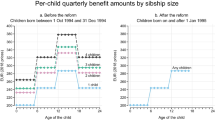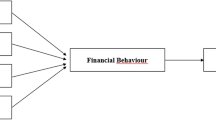Abstract
The objectives of this study are to determine effects of household members' characteristics, financial resources, and attitude toward intergenerational support on change in savings net worth and change in housing net worth. Subsamples of White respondents, Black respondents, and Hispanic respondents were analyzed to identify the effects of race or ethnicity on the dependent variables. Attitude toward intergenerational support was the intervening variable. Change in labor income had a positive impact on change in savings net worth for all three racial or ethnic groups. An additional child in a household and an older age of the household head were likely to decrease the change in savings net worth. Effects of the remaining variables differed by subsample. The effects of labor and nonlabor income were different for the change in savings net worth but not for the change in housing net worth. Some different effects for variables across the three racial or ethnic groups were noted.
Similar content being viewed by others
References
Andrews, D. W., & Fair, R. C. (1988). Inference in nonlinear econometric models with structural change. Review of Economic Studies, 55, 615-640.
Araji, S. K. (1977). Husbands' and wives' attitude-behavior congruence on family roles. Journal of Marriage and the Family, 39, 309-320.
Becker, G. S. (1981). A treatise on the family. Cambridge, MA: Harvard University.
Bentler, P. M. (1995). EQS structural equations program manual. Ancien, CA: Multivariate Software.
Bentler, P. M., & Dudgeon P. (1996). Covariance structure analysis: Statistical practice, theory, and directions. Annual Review of Psychology, 47, 563-592.
Blau, F. D., & Graham, J. W. (1990). Black-White differences in wealth and asset composition. The Quarterly Journal of Economics, 105, 321-339.
Bollen, K. A. (1989). Structural equation with latent variables. New York: John Wiley & Sons.
Chang, Y. R. (1994). Saving behavior of U.S. households in the 1980s: Results from the 1983 and 1986 Survey of Consumer Finance. Financial Counseling and Planning, 5, 45-64.
Chang, Y. R., & Hanna, S. D. (1994). Factors related to household saving. Consumer Interests Annual, 40, 148-155.
Derrick, F. W., & Lehfeld, A. K. (1980). The family life cycle: An alternative approach. Journal of Consumer Research, 7, 214-217.
Douthitt, R. A., & Fedyk, J. M. (1989). The use of savings as a family resource management strategy to meet child rearing costs. Lifestyles: Family and Economic Issues, 10, 233-248.
Eller, T. J., & Fraser, W. (1993). Asset ownership of households: 1993 (Current Population Reports, P70-47). Washington, DC: Government Printing Office.
Ferber, R. (1973). Family decision making and economic behavior: A review. In E. B. Sheldon (Ed.), Family economic behavior (pp. 29-61). Philadelphia, PA: J. B. Lippincott.
Fitzsimmons, V. S., & Leach, L. J. (1994). Net worth change: Beginning and expanding life cycle stages. Financial Counseling and Planning, 5, 65-82.
Foster, A. C., & Metzen, E. J. (1981). The impact of wife's employment and earnings on family net worth accumulation. Journal of Consumer Studies and Home Economics, 5, 23-36.
Gale, W. G., & Scholz, J. K. (1993). Intergenerational transfers and the accumulation of wealth (Discussion papers No.1019-93). Madison, WI: University of Wisconsin-Madison, Institute for Research on Poverty.
Hanna, S., & Prather, C. (1989). Net worth over the life cycle. In R. Walker (Ed.), Proceedings of the Family Economics/Home Management Preconference Workshop of the American Home Economics Association (pp. 12-21). Cincinnati, OH: American Home Economics Association.
Hao, L. (1996). Family structure, private transfers, and the economic well-being of families with children. Social Forces, 75, 262-292.
Hefferan, C. (1982). Determinants and patterns of family saving. Home Economics Research Journal, 11, 47-55.
Katona, G. (1975). Psychological economics. New York: Elsevier Scientific.
Liao, T. F. (1996, August). Comparing social groups: Wald statistics for testing equality among multiple logit models. Paper presented at the meeting of the American Sociological Association, New York City, NY.
Modigliani, F., & Brumberg, R. (1954). Utility analysis and the consumption function. In K. Kurihara (Ed.), Post-Keynesian economics (pp. 388-436). New Brunswick, NJ: Rutgers University Press.
Organization for Economic Cooperation and Development (1994). Taxation and household saving. Paris: Author.
Schultz, T. P. (1990). Testing the neoclassical model of family labor supply and fertility. Journal of Human Resources, 25, 599-634.
Smith, J. P. (1995). Marriage, assets, and savings. (Labor and Population Program Working Paper Series 95-08). Santa Monica, CA: RAND.
Smith, J. P., & Ward, M. P. (1980). Asset accumulation and family size. Demography, 17, 243-260.
Solmon, L. C. (1975). The relation between schooling and savings behavior: An example of the indirect effects of education. In F. T. Juster (Ed.), Education, income, and human behavior (pp. 253-294 and pp. 419-426). New York: McGraw-Hill.
Stampfl, R. W. (1978). The consumer life cycle. Journal of Consumer Affairs, 12, 209-219.
Sweet, J. A., & Bumpass, L. L. (1996). The National Survey of Families and Households-wave 1 and wave 2: Data description and documentation. Madison, WI: University of Wisconsin, Center for Demography and Ecology.
Sweet, J., Bumpass, L., & Call, V. (1988). The design and content of the National Survey of Families and Households. Madison, WI: University of Wisconsin, Center for Demography and Ecology.
Williams, F. L., & Manning, S. L. (1972). Net worth change of selected families. Home Economics Research Journal, 1, 104-113.
Wolff, E. N. (1996). Top heavy: The increasing inequality of wealth in America and what can be done about it. New York: The New Press.
Yuan, K., & Bentler, P. M. (1995). Mean and covariance structure analysis: Theoretical and practical improvements (UCLA Statistical Series Report No. 194). Los Angeles: University of California.
Author information
Authors and Affiliations
Rights and permissions
About this article
Cite this article
Wakita, S., Fitzsimmons, V.S. & Liao, T.F. Wealth: Determinants of Savings Net Worth and Housing Net Worth of Pre-Retired Households. Journal of Family and Economic Issues 21, 387–418 (2000). https://doi.org/10.1023/A:1026432705410
Issue Date:
DOI: https://doi.org/10.1023/A:1026432705410




